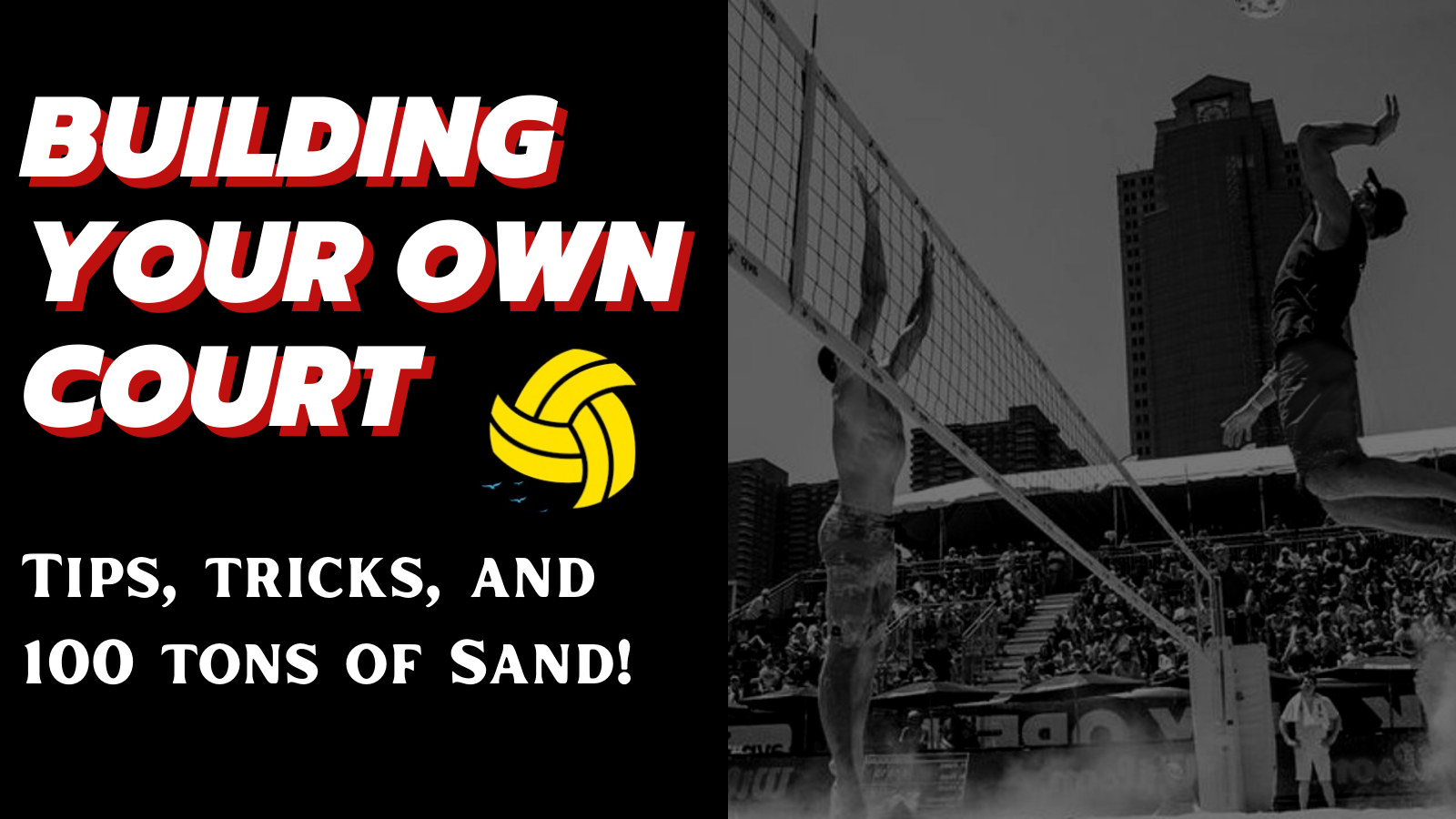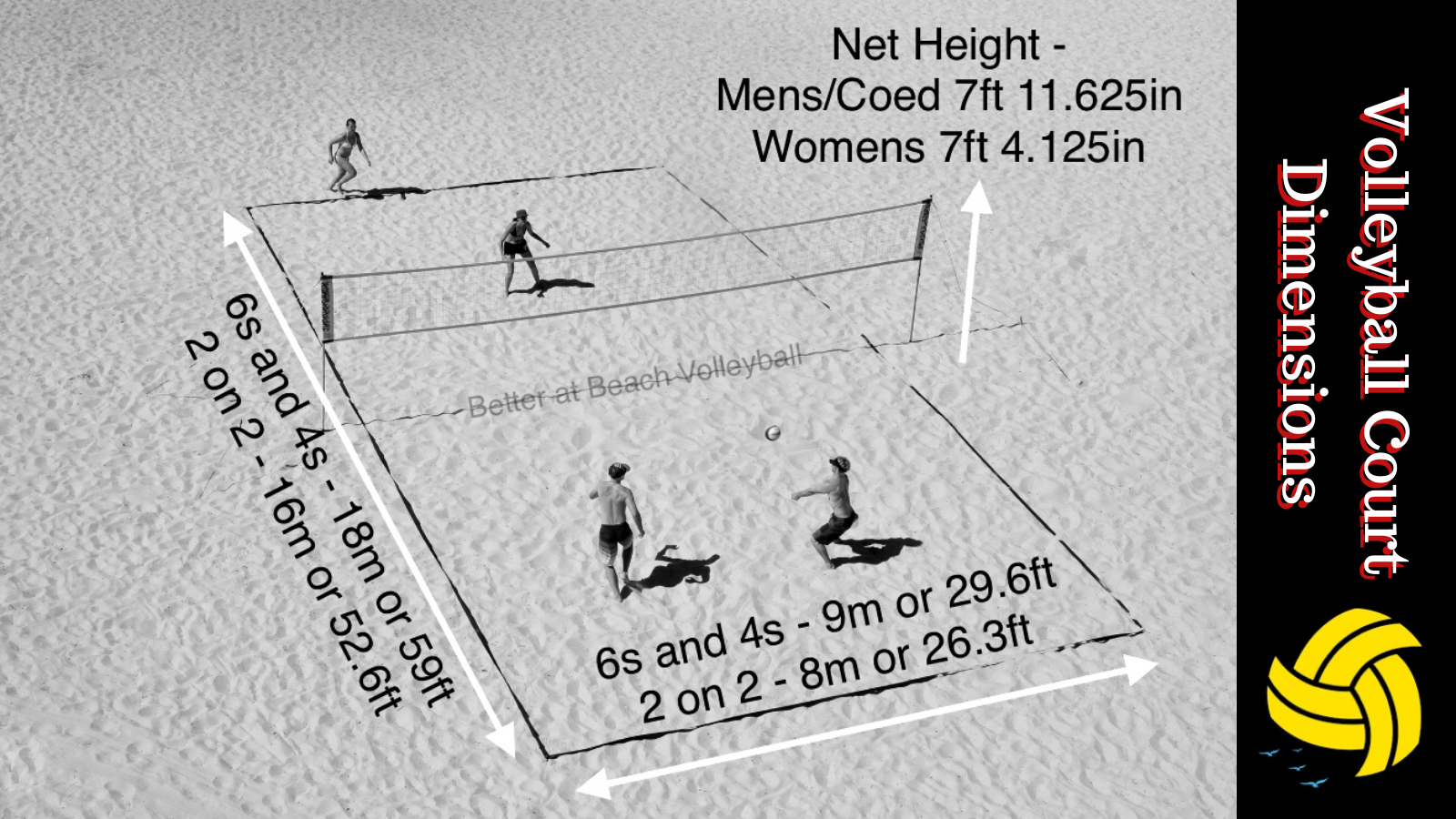
Everything You Need To Know About Volleyball Courts
Volleyball Courts : Net Heights and More!
Have you ever been playing volleyball and looked around and thought, “This court seems too big?” or had that game winning point paint the back line and you just KNOW there was no way that was possible? They must have the volleyball court dimensions wrong, right?? Well, to make sure you have that vital information, let’s talk about the court dimensions and volleyball net heights.
Want to hear/see Mark and Brandon explain all this? Check out our Everything You Need To Know About Volleyball Courts video!
What ARE the correct dimensions of the volleyball court?
"SIZE DOES MATTER"
Contrary to popular belief, size DOES matter, especially in volleyball. Let’s start with the big court commonly used in indoor volleyball or, if we are on the beach, where we would see 6s and 4s. The dimensions you are going to use are 9m by 9m or 29ft 6in by 29ft 6in. This will be the perfect playing setup for those wishing to play 6s or 4s in beach volleyball. How about those eager to play 2 on 2? In 2001, the rules and size of the beach volleyball court changed for 2 on 2. Now, instead of playing on the big court, the dimensions on each side of the net are 8m by 8m or 26ft 3in by 26ft 3in. For the entire court, all the line space that you need is 52.6ft by 26.3ft for your lines, if you need to cut them yourself.
It's not all on the inside that counts.
When creating your own court, always think about the space outside of the court as well. Whenever you are creating that space you need at least 10ft of space from the sideline to whatever grass or area you have outside of the court as well as on the end lines. You, also, need to think about the distance from the poles to the sidelines and for that you will need at least 3ft. So, Rule of thumb is to have at least 10ft around the outside of the court and 3ft from the poles to the sideline or where your antennas may be.
Volleyball Net Height
Don't get caught trying to measure by hands or stacking friends to estimate volleyball net height. If you are looking to achieve the exact net height - Most referees will carry a chain to hook onto the net with a red link for women’s volleyball net height and full length for men’s volleyball net height. Make sure to clear out the sand under the net to keep with a consistent level while measuring the precise volleyball net height.

Volleyball Net Antenna
All volleyball courts should have antennas which represent the sidelines and for the rules. You can imagine that the volleyball net antenna extends for eternity into the sky. If the ball travels over the antenna at any point, it is considered to be out of bounds. The ball needs to fly back and forth over the net between the antennas. As for the length and width of the volleyball net antenna, we suggest 1.8m (5’11”) in length and 22mm in thickness.
Want to show your support and help us make more content?
Buy one of these cool beach volleyball gears...
 |
|
|---|---|
BPS 'Second Skin' Soft and Ultra Stretch Water Socks High Cut Low Cut Unisex |
Beach Volleyball Lines
Was that in? Or out? The only way to know for sure is to set up your court with the proper beach volleyball lines. We suggest a two inch beach volleyball line especially if you are leaving them outside or on the ground for an extended period of time. If you are looking for a more portable version, we would recommend purchasing one inch or even the string line ropes.
"Did that line just move? No way that could have been their point? I demand a replay."
Sound familiar? Don’t get caught in this scenario and know how to keep the lines in place. Each line is held down by what is called an “anchor”. Anchors can come in a variety of options ranging from spikes to disc anchors which are great for beach volleyball. If you are playing grass volleyball, you are going to want to have metal spikes. They are typically sold together as a unit and can be found at one of the links below.
See EVERYTHING in our Amazon Shop!
Beach Volleyball Lines Setup
The best way to set up beach volleyball lines is to find the middle of the line that belongs underneath the net. Tell your buddy to hold the line there or you can drive an anchor into the ground to secure it. Once that is done, pull the line tight and take your anchor at 45 degrees with the point back in and down towards the volleyball court. This should provide a nice snug anchor and the volleyball lines should be taut to prevent excessive movement. Make sure when you are doing that to dig a little hole in the sand and cover the spike with sand; just so when someone steps on it, they don’t hurt their feet.
The Ten Foot Line
Another difference that we see between indoor and beach volleyball is “the three meter line” or “the ten foot line”. In indoor volleyball, that is used to mark where back row players can not attack in front of. We don’t have that in beach unless you are playing reverse coed, where the male on a team has to attack from behind the three meter or ten foot line. On the sand, what we commonly see is that people will mark out that with tape and then they will use a small string to go across the sand volleyball court. So, there is not a three meter or ten foot line on the sand.
"Wait, wait, wait! I know that net seems too low."
Thinking about reverse coed, there are a couple of different dimensions to talk about. When we are playing regular coed, the volleyball net height is still at the men’s height while reverse coed is played at women’s height.
Ready to setup your perfect volleyball court? Check out our favorite products below...
Sand Volleyball Poles
When we are talking about the poles that you need to actually hold the volleyball nets up, if you are indoor, those poles are probably already inserted into the gym floor. Usually, they are made up of stainless steel and have a lot of tension. Check these out.
If you are on the beach, we recommend treated wood with sanded edges to make sure nobody cuts themselves or runs into it too hard. If you are looking for sturdy sand volleyball poles that are long lasting, we suggest getting sixteen foot poles that are six by six inches. A four by four inch pole can be used, but the amount of tension causes bending and cracking over long periods of time. You should bury the pole about five feet into the sand to keep the net from shifting over. With the thinner or portable nets, like Park and Sun or Spectrum, you will have guy wires from the top of the net that you will also anchor into the ground to provide additional tension. They do tend to be less sturdy but will get the job done if you are out just for a day or two. If you are looking for a more permanent solution, go ahead and get some treated wood and some eye rings that can hold excessive tension. You can set these eye rings at 9.5 feet off the sand and another one at 3.5 feet off the sand. Also, adding an extra one to have a pulley system in between them will assist in raising and lowering the sand volleyball net. Work smarter, not harder. The bottom eye ring will help keep the net pulled down and increase tension across the bottom. We highly recommend getting covered steel cables with the proper clasps and pulley system to help extend the life of your ropes.
Curious how to tie the knots for a professional setup as described?
Check out this video How to Set Up a Beach Volleyball Net (Knot-Tying Secrets to Make Your Life Easier!
Portable nets can be found here.
If you are interested in a permanent setup with a high quality net, we suggest the customizable net at VolleyballUSA.

How to build your own Sand Volleyball Court
So, you are sold out and want to know how to build a sand volleyball court at your house? Here are a few tips to make sure you have the best sand volleyball court in the neighborhood.
You will want to start by digging, at least, a foot and a half to three feet deep before filling with sand. Don’t forget to install a proper drainage system. Laying PVC pipes with some holes in them will be a great start. Covering those pipes with some little rocks will help the runoff especially if you live in an area where you get a lot of rain. You will finish by filling your court with a MINIMUM of 100 tons of sand. Yes, that is a lot of sand, but we want to make sure that you are healthy. Nobody likes a shallow beach volleyball court. Where does one find that amount of sand if they don’t have easy access to such? If you cannot find it locally, we recommend our friends at SandCourtExperts.
Indoor Volleyball Court Floors
Age may not be the only thing making those knees hurt. If you are wondering about what your indoor courts should be made of, always keep your athletes in mind. Be kind to those bodies and steer clear of concrete or very hard surfaces with little or no give. We suggest using Sport Court or finding a nice basketball type gym that is already established.
We hope that you have gained all the knowledge to build your own court and start living the volleyball dream. Now, get out there and win more games. See you on the courts!











